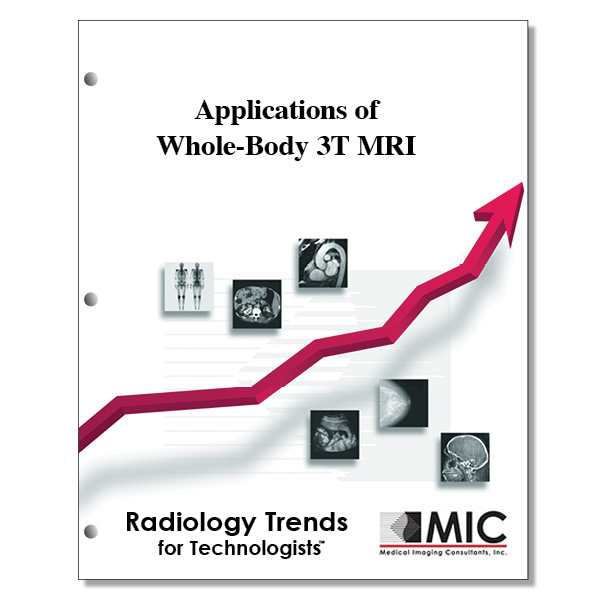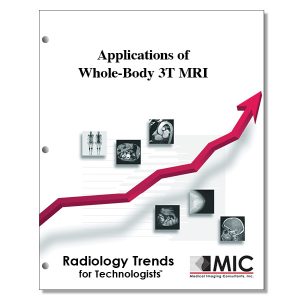

Applications of Whole-Body 3T MRI
In the second of a two-part series about high-field-strength MR imaging, clinical applications are presented.
Course ID: Q00463 Category: Radiology Trends for Technologists Modality: MRI3.0 |
Satisfaction Guarantee |
$34.00
- Targeted CE
- Outline
- Objectives
Targeted CE per ARRT’s Discipline, Category, and Subcategory classification for enrollments starting after January 28, 2025:
[Note: Discipline-specific Targeted CE credits may be less than the total Category A credits approved for this course.]
Magnetic Resonance Imaging: 2.75
Procedures: 2.75
Neurological: 1.00
Body: 0.75
Musculoskeletal: 1.00
Outline
- Introduction
- Body Applications of High-Field-Strength MR Imaging
- Cardiac MR Imaging
- Breast
- Abdomen
- Pelvis
- Musculoskeletal Applications
- Proton MR Spectroscopy
- Pediatric Imaging
- Conclusion
Objectives
Upon completion of this course, students will:
- identify techniques used in the reduction of repeat sequences in the setting of clinical patient motion
- establish the advantages of fat separation techniques in MRI sequences
- identify which MR system design proves most advantageous in the setting of patients presenting with claustrophobic or bariatric conditions, while maintaining diagnostic accuracy
- define the magnetohydrodynamic effect as it applies to cardiac MRI
- establish the primary disadvantage of steady-state free precession sequences in cardiac MRI applications
- identify the corrective measures to susceptibility effects in steady-state free precession sequences
- establish the primary advantage when utilizing parallel imaging in cardiac MRI
- understand the effect on saturation as flip angles are adjusted in gradient echo sequences
- define saturation in an MRI pulse sequence
- establish and define the condition of steady state
- identify the optimal imaging modality when evaluating for coronary artery stenosis
- identify the advantages and uses of cardiac perfusion
- define the function of myocardial tagging techniques
- identify breast cancer in an MRI imaging scenario
- define the technical requirements of contrast imaging with breast MRI protocols
- identify the cause of T1 variations in breast imaging at 3T
- identify the sequences defined as functional breast MRI techniques
- define dynamic susceptibility contrast sequences
- establish the advantages in MR spectroscopy at higher field strengths
- learn the corrective method to SAR-related difficulties in 3T imaging of the abdomen
- identify the overall image contrast effect of higher field strength imaging when utilizing iron oxide-based contrast agents in the liver
- identify the newest vendor mechanism in reduction of respiratory motion artifacts in abdominal MRI
- identify the pancreas as an organ specifically benefitting from the increased spatial resolution possible at 3T
- identify corrective measures in the reduction of respiratory motion artifacts in prostate MRI
- establish proper patient preparation measures that help to reduce artifacts from abdominal/bowel motion
- show the advantage in applying functional imaging in the prostate gland
- identify the advantage of 3T as applied to prostate MR spectroscopy
- learn the techniques in female pelvic MRI used to improve patient outcomes and increase compliance
- identify the value of 3T pelvic MRI in the setting of local tumor staging
- identify the advantages of 3T fat suppression in musculoskeletal applications
- define the primary disadvantage of 3T as applied to musculoskeletal MRI
- learn the main corrective measure to chemical shift artifacts
- identify the goal of MRI pulse sequences in cartilage examinations
- define T2 mapping techniques
- establish optimal scan conditions with smaller joints
- learn to clinically apply spectroscopy at higher field strengths
- understand the impact of 3T on the spectroscopy volume
- identify the regions most prone to the susceptibility effects of 3T spectroscopy applications
- establish the advantages of high field as it applies to pediatric imaging populations
- define the primary disadvantage in high field strength pediatric MRI
